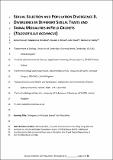Sexual selection and population divergence II. Divergence in different sexual traits and signal modalities in field crickets (Teleogryllus oceanicus)
Date
07/06/2017Grant ID
NE/G014906/1
NE/L011255/1
Ne/I027800/1
Keywords
Metadata
Show full item recordAbstract
Sexual selection can target many different types of traits. However, the relative influence of different sexually selected traits during evolutionary divergence is poorly understood. We used the field cricket Teleogryllus oceanicus to quantify and compare how five traits from each of three sexual signal modalities and components diverge among allopatric populations: male advertisement song, cuticular hydrocarbon (CHC) profiles and forewing morphology. Population divergence was unexpectedly consistent: we estimated the among-population (genetic) variance-covariance matrix, D , for all 15 traits, and D max explained nearly two-thirds of its variation. CHC and wing traits were most tightly integrated, whereas song varied more independently. We modeled the dependence of among-population trait divergence on genetic distance estimated from neutral markers to test for signatures of selection versus neutral divergence. For all three sexual trait types, phenotypic variation among populations was largely explained by a neutral model of divergence. Our findings illustrate how phenotypic integration across different types of sexual traits might impose constraints on the evolution of mating isolation and divergence via sexual selection.
Citation
Pascoal , S , Mendrok , M , Wilson , A J , Hunt , J & Bailey , N W 2017 , ' Sexual selection and population divergence II. Divergence in different sexual traits and signal modalities in field crickets ( Teleogryllus oceanicus ) ' , Evolution , vol. 71 , no. 6 , pp. 1614-1626 . https://doi.org/10.1111/evo.13239
Publication
Evolution
Status
Peer reviewed
ISSN
0014-3820Type
Journal article
Description
Funding was provided by Natural Environment Research Council grants to N.W.B. (NE/G014906/1, NE/L011255/1, NE/I027800/1), a University of California Pacific Rim Research Grant to N.W.B. (08.T.PRRP.05.0029), an Erasmus exchange grant to support M.M., a University Royal Society Fellowship and Royal Society Equipment Grant to J.H., and a BBSRC David Phillips Fellowship to A.J.W.Collections
Items in the St Andrews Research Repository are protected by copyright, with all rights reserved, unless otherwise indicated.

